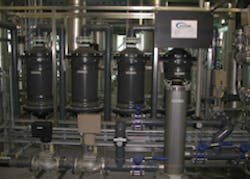Dissolved Gas Control
Central district heating systems have gained attention in recent years because they can be more efficient than localized boiler units. The efficiency of district heating is usually realized due to power generation plants being able to produce heat and electricity simultaneously. They also use more advanced flue gas cleaning than single-boiler systems, resulting in better pollution prevention.
In central district heating systems, heated water from power plants is distributed to densely populated residential and industrial areas by insulated piping networks. Large storage tanks are typically used to safely store heat for use during periods of peak load demand. High water quality is required to maintain the integrity of a centralized system’s infrastructure.
To prevent internal corrosion and to increase the lifetimes of piping and storage tanks, water needs to be treated carefully. Inlet water is typically filtered and softened, and it has low oxygen content. Impurities are removed during the initial filling of the system; however, water is also needed to feed the recirculation system that is used to compensate for any water loss during operation or seasonal fluctuations. As part of this refilling system, Jotem Waterbehandling BV installed Liqui-Cel membrane contactors for O2 removal at a Netherlands power station.
The solution
The technology behind Liqui-Cel membrane contactors is based on Henry’s Law, which states that gasses will dissolve in water relative to their partial pressure above the liquid. The solubility constant (Henry’s Constant), which is different for each gas, also depends on temperature. Water below atmospheric standard conditions (20°C, 1 bar) and in contact with ambient air, contains up to 8 to 9 ppm (mg/L) of oxygen.
Water flows through the contactor on the outside (shell side or liquid side) of the hollow fiber membrane. Because the membrane is microporous and hydrophobic, only the gas molecules are able to pass through the membrane. Applying a vacuum or using an inert sweep gas on the lumen side will lower the partial pressure of the gas that needs to be removed, and excess gasses will be carried away into the vacuum.
System design
The goal was to achieve an O2 specification of fewer than 10 ppb for filling the storage water tanks and to maintain a constant fill level. For an inlet water flow of 30 cu m/hr, Jotem installed four 14-in. Liqui-Cel contactors connected in series. To achieve the low O2 requirements, the system operates in N2-vacuum (combo) operation. The vacuum pump pulls vacuum through a parallel connected manifold from the bottom gas ports, while the N2 sweep gas enters the contactors through the top gas ports. The O2 content is reduced through each membrane step.
The necessary 2.2 cu m/hr of total nitrogen sweep gas (0.55 cu m/hr for each module) is produced in a separate N2 generator with a pressure swing absorption technique. This generator constantly creates N2 gas with a purity of greater than 99.99% (100 ppm of O2) from ambient air. For each cubic meter of N2, about 6 cu m of compressed air (at 6 bar) is required.
The nitrogen can be stored in pressurized tanks during system standby.
The vacuum level of 66 mbar absolute (50 torr) is created by a liquid ring vacuum pump with an external water-cooling system. The service water is recycled to about 50% by a gas/water separator.
Results
The system exceeded expectations, achieving oxygen removal down to 5 ppb. The main advantage of the Liqui-Cel membrane contactor system compared to conventional degassing technology is its small footprint. This allowed Jotem to install the O2 removal system close to the point-of-use at the power station’s storage tanks, saving additional piping and space costs.
The chemical-free, deoxygenation system without an external N2 supply provided an excellent water treatment solution with low energy demand and operating costs.
